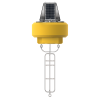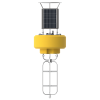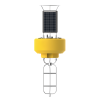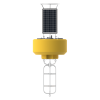Garmin GPS 24xd HVS Marine GNSS Receiver
Features
- Provides access to GPS, Galileo, GLONASS and BeiDou satellite systems
- Accurate to <1 meter CEP, <3 meters 95%
- IPX7 waterproof sensor with pole and flush mount options
- Free ground shipping
- Expedited repair and warranty service
- Lifetime technical support
- More
GPS 24xd HVS
The highly accurate GPS 24xd HVS position receiver/antenna provides up to 10 Hz update rates for position, velocity and time data. It offers high-sensitivity reception and enhanced position acquisition to the Garmin family of marine instruments, autopilots and multifunction displays.
Delivers Precise Location Data
This receiver is capable of tracking multiple global navigation satellite systems, including GPS, Galileo, GLONASS and BeiDou. Since more satellites are visible, it can provide more accurate fixes in challenging conditions. WAAS-capable, it can determine precise location to within <1 meter CEP, <3 meters 95%.
Observable Advantages
Compared to units with slower update rates, the GPS 24xd offers dramatic improvement when used at low speeds. Position and course information from slower units can jitter and swing considerably at speeds below 1 mph. The GPS 24xd provides a consistent and smooth heading which is especially important when trying to hit a specific waypoint or mark.
Built for Versatility
Part of the Garmin marine instrument family, the GPS 24xd HVS is built to withstand the elements. This waterproof (IPX7) sensor can be pole mounted or flush mounted. It also can be attached to the underside of many fiberglass decks for added ease of installation. In addition, it also can be configured to have 1 Hz or 5 Hz update rates to help support specific installation requirements.
- Dimensions (D x H): 3 19/32" x 1 15/16" (91.6 mm x 49.5 mm)
- Weight: 7.1 oz (201 g)
- Cable length: 30 ft (9.14 m)
- Temperature range: -22° to 176° F (-30° to 80° C)
- Case material: Fully gasketed, high-impact plastic alloy; waterproof to IPX7
- Compass-safe distance: .5" (12.7 mm)
- Power source input: 8-32V, unregulated
- Input current: 150 mA at 12 Vdc
- Position accuracy, typical marine use: < 50 cm, CEP 50%; < 1.0 meter, 88%
- GPS 24xd HVS
- Pole mount
- Surface mount
- Under deck mount
- Power/data cable
- Update rate select cable
- Documentation
In The News
From Hurricanes to Florida’s Red Tides: Monitoring the Southwest Gulf Coast
Nearly every year, southwest Florida is blighted by harmful Karenia brevis blooms–known colloquially as Florida red tides. These harmful algal blooms (HABs) form over the West Florida shelf and are pushed shorewards by winds and currents. Once in touching distance of the coast, they often intensify, fed by land-based runoff, anthropogenic nutrients, and decomposing marine life killed by toxins produced by these red tides. Red tides have become more severe and persistent over the past 20 years, causing major environmental and economic damage.
Read MoreWave-Powered Buoy Deployed in Puget Sound
While the development of solar-powered monitoring systems has improved access to real-time environmental data, solar power is still limited by low light conditions, such as poor weather, nighttime, or high-latitude environments. To supplement these incumbent power solutions at sea, Ocean Motion Technologies has developed a small-scale ocean wave energy system that can be directly integrated with existing data buoy platforms. Not only does wave energy supplement solar power during periods when the buoys are limited by light availability, but it also allows data buoys to perform beyond their current power capacities.
Read MoreLong-Term Monitoring in the Chautauqua Lake Watershed
With a widely developed shoreline, Chautauqua Lake experiences influxes of non-point source pollution that have historically impacted the health of the lake. The Chautauqua Lake Association (CLA) has been monitoring the lake for over two decades, reporting on changes that have occurred over the years. A pair of local lake advocates, Jane and Doug Conroe, have lived on the lake for over 40 years and have played an important role in establishing monitoring programs and facilitating consistent data collection throughout the watershed. Doug has been involved with the Chautauqua Lake Association (CLA) since the pair moved to the area in 1980, and is currently serving as the Executive Director.
Read More















